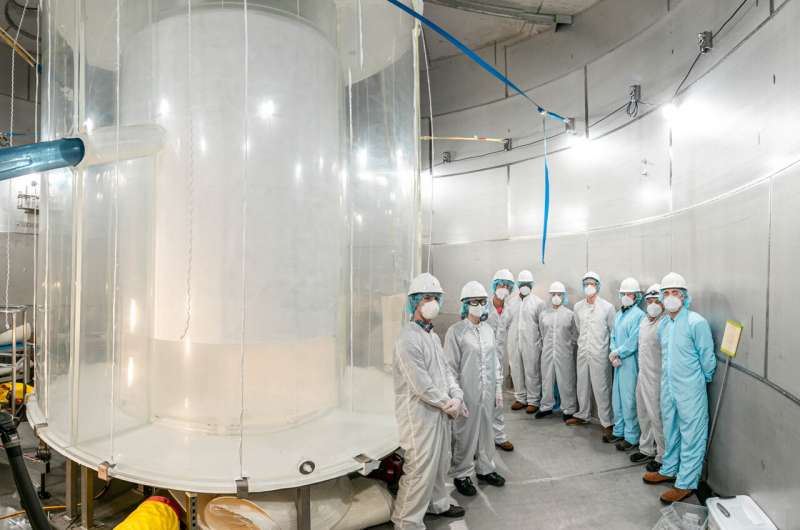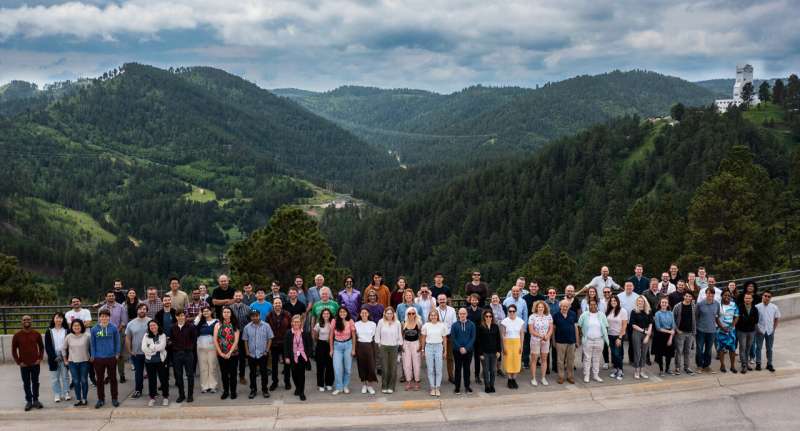
LZ’s central detector, the time projection chamber, in a clean room of a surface laboratory before being moved underground. Photo credit: Matthew Kapust/Sanford Underground Research Facility
Understanding the nature of dark matter, the invisible substance that makes up most of the mass of our universe, is one of the greatest mysteries in physics. New results from the world’s most sensitive dark matter detector, LUX-ZEPLIN (LZ), have narrowed down the possibilities for one of the leading dark matter candidates: weakly interacting massive particles, or WIMPs.
LZ, led by the Department of Energy’s Lawrence Berkeley National Laboratory (Berkeley Lab), is searching for dark matter in a cave about a mile underground at the Sanford Underground Research Facility in South Dakota. The experiment’s new results probe weaker interactions with dark matter than ever before and further constrain the capabilities of WIMPs.
“These are new, world-leading constraints on dark matter and WIMPs,” said Chamkaur Ghag, LZ spokesperson and professor at University College London (UCL), noting that the detector and analysis techniques perform even better than expected from the collaboration.
“If WIMPs were in the region we searched, we could have made confident statements about them. We know we have the sensitivity and tools to determine if they are there while we search at lower energies, which takes up most of the runtime of this experiment.”
The collaboration found no evidence of WIMPs above a mass of 9 gigaelectronvolts/c2 (GeV/c2). (For comparison: The mass of a proton is slightly less than 1 GeV/c2.) The experiment’s sensitivity to weak interactions helps researchers reject potential WIMP dark matter models that don’t fit the data, leaving far fewer places for WIMPs to hide.
The new results were presented on August 26 at two physics conferences: TeV Particle Astrophysics 2024 in Chicago, Illinois, and LIDINE 2024 in São Paulo, Brazil. A paper will be published in the coming weeks.

An array of photomultiplier tubes designed to detect signals from particle interactions taking place in LZ’s liquid xenon detector. Image credit: Matthew Kapust/Sanford Underground Research Facility
The results analyze 280 days of data: a new set of 220 days (collected between March 2023 and April 2024) combined with 60 previous days from LZ’s first run. The experiment is scheduled to collect 1,000 days of data before it ends in 2028.
“If you think of the search for dark matter as looking for buried treasure, we dug almost five times deeper than anyone has before,” said Scott Kravitz, LZ’s deputy physics coordinator and a professor at the University of Texas at Austin. “You don’t do it with a million shovels – you do it by inventing a new tool.”
The sensitivity of LZ is based on the countless ways in which the detector can reduce backgrounds, false signals that can mimic or conceal an interaction with dark matter. Deep underground, the detector is shielded from cosmic radiation from space.
To reduce the natural radiation from everyday objects, LZ is built from thousands of ultra-clean, low-radiation parts. The detector is constructed like an onion, with each layer either blocking outside radiation or tracking particle interactions to rule out dark matter mimics. And sophisticated new analysis techniques help rule out background interactions, particularly those of the most common culprit: radon.
This result is also the first time LZ has used “salting” – a technique that adds false WIMP signals during data collection. By disguising the real data until “desalting” at the end, researchers can avoid unconscious bias and avoid over-interpreting or altering their analysis.

LZ team members in the LZ water tank after installing the external detector. Photo credit: Matthew Kapust/Sanford Underground Research Facility
“We’re pushing the frontier into a realm where no one has ever looked for dark matter before,” said Scott Haselschwardt, the LZ physics coordinator and recent Chamberlain Fellow at Berkeley Lab who is now an assistant professor at the University of Michigan. “There’s a human tendency to want to see patterns in data, so it’s really important that you don’t introduce bias into this new realm. When you make a discovery, you want to get it right.”
Dark matter, so named because it does not emit, reflect, or absorb light, makes up an estimated 85% of the mass of the universe. However, it has never been directly detected, although it has left its mark in numerous astronomical observations. Without this mysterious yet fundamental part of the universe, we would not exist. The mass of dark matter contributes to the gravitational attraction that helps galaxies form and stay together.
LZ uses 10 tons of liquid xenon to create a dense, transparent material that dark matter particles can potentially collide with. The hope is that a WIMP will collide with a xenon nucleus and set it in motion, similar to hitting a billiard ball in a game of billiards. By collecting the light and electrons emitted during the interactions, LZ will capture potential WIMP signals, among other data.
“We have shown how strong we are as a WIMP search engine and we will continue to do better – but there are many other things we can do with this detector,” said Amy Cottle, leader of the WIMP search effort and assistant professor at UCL.
“The next step is to use these data to study other interesting and rare physical processes, such as rare decays of xenon atoms, neutrinoless double beta decay, boron-8 neutrinos from the Sun, and other physical processes beyond the Standard Model. And this is in addition to studying some of the most interesting and previously inaccessible dark matter models of the last 20 years.”

Members of the LZ collaboration meet at the Sanford Underground Research Facility in June 2023, shortly after the experiment began its latest science run. Image credit: Stephen Kenny/Sanford Underground Research Facility
LZ is a collaboration of around 250 scientists from 38 institutions in the USA, Great Britain, Portugal, Switzerland, South Korea and Australia; much of the work in setting up, operating and analyzing this record-breaking experiment is done by young researchers.
The collaboration is already looking forward to analyzing the next dataset and using new analytical tricks to search for even lower-mass dark matter. The scientists are also thinking about possible upgrades to further improve LZ and are planning a next-generation dark matter detector called XLZD.
“Our ability to search for dark matter is improving faster than Moore’s Law,” Kravitz said. “If you look at an exponential curve, everything that has come before is nothing. Just wait and see what comes next.”
Provided by Lawrence Berkeley National Laboratory
Quote: Experiment sets new record in search for dark matter (26 August 2024), retrieved on 26 August 2024 from https://phys.org/news/2024-08-dark.html
This document is subject to copyright. Except for the purposes of private study or research, no part of it may be reproduced without written permission. The contents are for information purposes only.

